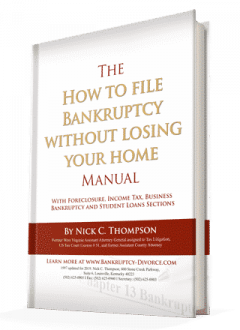How to file a Kentucky do it yourself Bankruptcy petition
First, I have a word of caution if you are filing a do it yourself Bankruptcy petition. I rarely advise clients to file for bankruptcy or defend a foreclosure without an attorney. There are about 120 different legal defenses you can make against a mortgage company when they file a foreclosure. No two lawsuits or bankruptcy cases are exactly alike. There are billions of combinations of moves that can be made in a chess game. You will be on your own and their attorney will not tell you your best actions if you are fighting the bank. He works for the bank and himself. His solutions will make the bank and his law office a profit.

Miss the deadline to assert a defense in court and you often waive that right and never get to use it. Fail to prepare your bankruptcy petition properly, and you can lose property or be forced into a more expensive bankruptcy. In a Chapter 7 bankruptcy, your case will be dismissed if you don’t follow the rules. But if you do follow the rules, you can get your case through. Filing a do it yourself bankruptcy prose is better generally than negotiating a debt management plan. Credit counseling and debt management plans have a 95% or higher failure rate and are rarely completed.
Filing a Bankruptcy with zero filing fee costs.
It may be that in your financial situation, you have no money to afford an attorney or even pay the filing fee. If you are very poor, you can even file a motion to waive the filing fees, which in 2022 was $338.00. I have seen a woman who had three children making $15 per hour while working through nursing school who needed to file bankruptcy. She had two garnishments, and her only choices seemed to be dropping out of school or filing bankruptcy.
In cases like this, life can become impossible when you pay out for two garnishments from your check. The average attorney fee for a Chapter 7 bankruptcy in 2022 is almost 2000 dollars nationwide. The judge will review your budget and waive the filing fee if paying the filing fee means you will do without food, utilities, or medical care. He looks at all of the factors. Even if you can afford these items, other necessities may require waiving the filing fee by filing a simple motion.
Kentucky do it yourself Bankruptcy petitions
We explain each of the schedules for a Chapter 7 filing. If you must file bankruptcy and you are going to do it yourself, our website will show you some of the methods and items to check as you prepare petitions step by step. Kentucky and 19 other states use the federal exemptions, which allow you to keep property. The states which use the federal exemptions include Alaska, Arkansas, Connecticut, District of Columbia, Hawaii, Kentucky, Massachusetts, Michigan, Minnesota, New Hampshire, New Jersey, New Mexico, New York, Oregon, Pennsylvania, Rhode Island, Texas, Vermont, Washington, and Wisconsin
We discuss and use the federal exemptions. However, some states like Indiana, Florida, Texas, and California use their own state exemptions. Often the exemptions are higher in these states.
A bankruptcy petition is similar to an accounting balance sheet and cash flow statement. There is also a means test and 26 questions in a statement of financial affairs. If you are filing a Chapter 13, you should especially use an attorney. Hiring attorney does not increase your Chapter 13 payment. Normally the unsecured creditors are simply paid less. Chapter 13 is your only option if you have filed a Chapter 7 within the prior eight years. You calculate the waiting period from filing the first Chapter 7 to the second filing date.
Why A Chapter 13 is rarely a DIY pro se option.
Chapter 13 is required if your disposable income is too high and you fail the means test. Chapter 13s are best used for particular purposes such as catching up on a mortgage or managing tax and student loans debts. In cases where a cosigner must be protected, you may want to use Chapter 13. Chapter 13 can also allow you to keep property you would have lost in Chapter 7. The exemptions will enable you to keep only so much property.
Chapter 13 cases are more complex and must file a plan of reorganization. Over 95% of the Chapter 13s filed in California fail if the debtor does not use an attorney. Chapter 7 cases normally involve debtors with small incomes and small amounts of exempt property. People are much more likely to complete a do-it-yourself Chapter 7 than Chapter 13. It is best if a Debtor thinks of the Chapter 13 plan as a contract. If debtors make 36-60 payments on time and complete a Chapter 13, they get to save their home, car, or stop an IRS and student loan collections.
Filing a do it yourself petition in a Chapter 7 Bankruptcy
Filing a Chapter 7 solves almost all unsecured debts which was what Chapter 7 was designed for. Most Chapter 7 cases are filed by debtors with little or no income or assets. You can redeem personal property in Chapter 7 and strip a judicial lien. However, Chapter 7 is limited in managing secured debts. You can often stretch out the payments in a Chapter 13 but you can’t strip a second mortgage like a Chapter 13 can.
Chapter 7 does not manage priority debts like income taxes less than three years old. Chapter 7 only delays and treats the symptoms of a priority debt. After the Chapter 7 case is over the unsecured debts are normally discharged. Debts due to drunk driving, fraud or for student loans may or may not be discharged. But in a Chapter 7 the priority debts will survive the Chapter 7 normally and return to garnishing wages, bank accounts and seizing assets.
A Chapter 13 can manage or catch up secured and priority debts over time, often curing the problem. The attorney fee in Chapter 13 is $4,000 or more and set by the court. Attorney fees are paid over time from the payments paid into Chapter 13. Often using an attorney in a 13 saves you enough that your monthly payments will be less than if you draft the petition and plan.
Filing an emergency skeletal petition Bankruptcy
The temporary court order called a stay stops foreclosures, garnishments, bank account seizures, and repossessions. It goes into effect immediately upon filing. In some cases, you may need to file an emergency skeletal petition. Filing repeated petitions with no intention other than to delay collections will often get you banned from filing bankruptcy for years. But in emergencies, you can file a skeleton petition by submitting the
- Voluntary petition section and
- credit counseling certificate
- creditor matrix
You must then complete the remaining schedules within about seven days. The Court will dismiss your case if the remaining schedules are not filed on time. If you chain file cases one after another, the second or third time you file the stay will little or no effect. So you must file a do-it-yourself bankruptcy correctly even if there are emergency circumstances.
